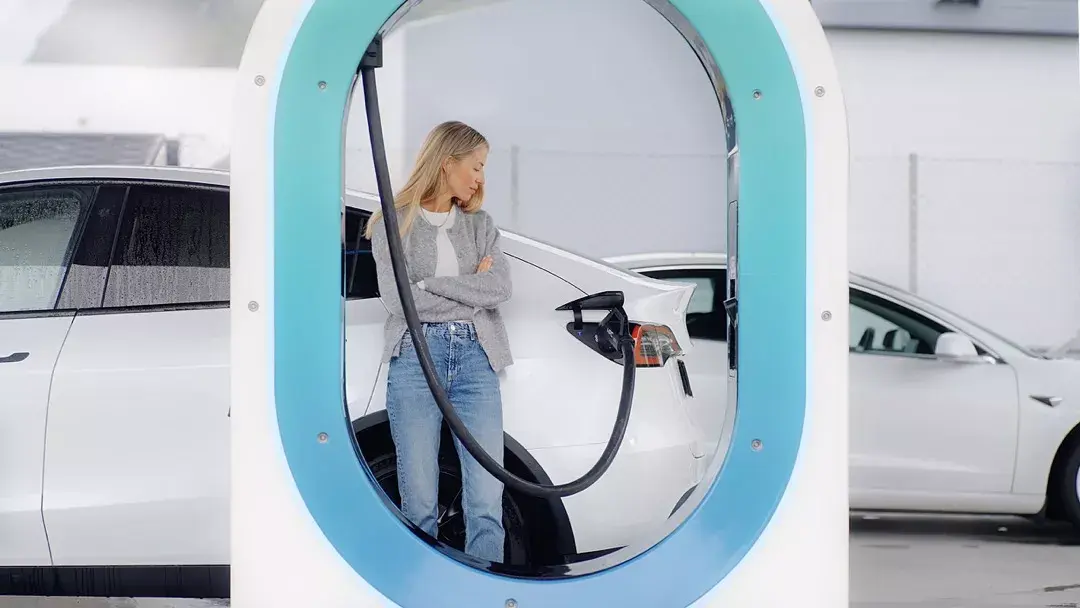
Whether you manufacture and produce EV chargers, or your business offers them for use by employees or the public, dynamic load management broadens the horizons of smart energy management and creates many opportunities for business growth, EV cost savings, and getting ahead of the EV infrastructure curve before demand increases.
What is dynamic load management?
Dynamic load management, put simply, is the transfer of energy between different assets within a facility – in this case, charging stations. A location or building will have a set amount of energy available and this can be controlled, dynamically, to ensure the energy is going where it’s most needed.
For some facilities, there might be something in place to measure the amperage or kilowatts on the boundary condition as well, although that’s not mandatory. For example, a business might want to distribute power evenly in order to not exceed the building’s limits.
The benefits
When it comes to the benefits of dynamic load management, the list is long and broad. From the perspective of the distribution network operator (DNO) – the entity which owns and operates the power infrastructure – it’s all about aggregated consumption on a transformer level and load management ensuring that the transformer is stable.
For the customers of the DNO – businesses or retail parks, for example – dynamic load management allows more control over the energy being used. Some of the benefits include:
- Peak shaving to better manage costs
- Avoiding power overloads
- Reducing strain on the grid during peak times, especially in areas where grid capacity is limited
This is the first step toward effective peak management and making sure e-mobility is not the asset that spikes your energy bill.
How can dynamic load management help a business to scale?
Any business that’s able to implement EV charging infrastructure will be able to scale thanks to dynamic load management, simply because it offers so much visibility and control over the way you use energy. Some examples are:
Destinations
Common destinations for charge points, such as retail parks, car parks, and hotels, can increase the number of chargers they have without overloading the grid or increasing energy costs. This will bring in new business while also saving on energy, which creates profits and, therefore, growth.
Charge point operators
Charge point operators and manufacturers can leverage dynamic load management to offer more chargers to a variety of locations and future-proof their business for when more demand inevitably occurs.
Workplace charging
It’s very inefficient to have EV-driving members of staff leaving the building to move their vehicles to charge or stop charging; dynamic load management means there’s no need for that. With a smart EV charging system that covers an entire car park worth of vehicles, once a car is fully charged, the next starts charging without unplugging the first. In the long run, it’s cheaper to buy an extra charge point than to have employees lose focus in the middle of the workday to move their car.
One corporation in Norway used to have a rule where employees could charge for just three hours and then had to move their car. During the working day, at least a third of employees would need to leave multiple times just to free up a charger — time that could’ve been spent working.
Multiple employees taking 10+ minutes out of their day and disrupting their workflow amounts to a considerable amount of wasted time – which is why the business reached out to CURRENT for help. Once we got involved, this was no longer a problem because we could just queue the different vehicles and make sure everybody had enough energy. No more leaving work to move a car. This increased productivity across the business.
Optimizing smart charging through standardization
Smart charging facilitates dynamic load management. In order to control the energy flow, the system needs to be able to communicate with the charger and collect the relevant data.
The open charge point protocol (OCPP) is a way for a charger to talk to your charge point management system. It standardizes the way chargers communicate with vehicles and management systems, improving the user experience and data collection — this allows for more accurate reporting and superior functionality. The most deployed version currently is OCPP 1.6, and the newest is OCPP 2.0.1
At CURRENT, we highly recommend hardware producers get their chargers certified to prove they can meet the needs of these core functionalities because the OCPP is a bit like the English language: lots of countries speak it, but it might sound very different with a huge variety of dialects. Eventually, it can not only become overly simplified, but an inability to speak the same language leads to loss of functionality and, as a result, control.
How CURRENT’s platform works
For the sake of the businesses needing to balance the energy requirements of their chargers, our charge point management system is directly connected to the asset – the charger – and we communicate with that through the OCPP. Our dedication to complying with the OCPP is one of the unique elements of our smart charging capability. It gives us the advantage of being able to seamlessly work with any smart charging station that is capable of charging according to the OCPP.
When we get new hardware, we certify it so we know what it can and can’t do. In cases where energy is a capacity or cost issue, we would control the charger and set up operating rules to optimize the outcome. Then, the limitation is simply what charger you have.
Our technology controls the charge point directly, and we dynamically adjust the amount of energy flowing to that particular asset at any given time. We set rules for this, including the maximum energy peak, which can be alternated across the site. To be able to do this, you need is a charger that’s built to the correct standards and is able to pass the two compliance tests.
We can control each charge point individually and set the current at a given time. We can even alternate between two different queue settings – either a ‘first come, first served’ situation or a ‘round robin’, where we reset the number of kilowatt-hours each car is getting before it puts them back in the queue. The bigger the battery, the more laps of the queue are required.
Additionally, we can set an alternate boundary condition for the charger like a peak roof – either for all day, every day, or from time to time – so we can manage everything together. If we also have extra hardware on-site, we can conduct that management dynamically by measuring the current going into the main circuit of the building.
CURRENT’s system also allows for optimization in cooperation with the facility manager, so they understand any issues and know what the desired outcome is. For example, a multi-unit dwelling in Oslo with over 200 charge points didn’t get its load management right the first time and ended up with high peaks and enormous energy bills. CURRENT stepped in and helped it deploy functionalities that suited it better — this saved the equivalent of around £4,000 each month.
The more people using OCPP and dynamic load management, the better it will become. Using standardized, compliant charge points prevents huge amounts of hard-earned equity being wrongly invested in devices that aren’t equipped to intelligently manage energy. By utilizing smart charging, businesses of all types can better manage their energy needs in order to grow.
To learn more about dynamic load management and what we do at CURRENT, get in touch today.



